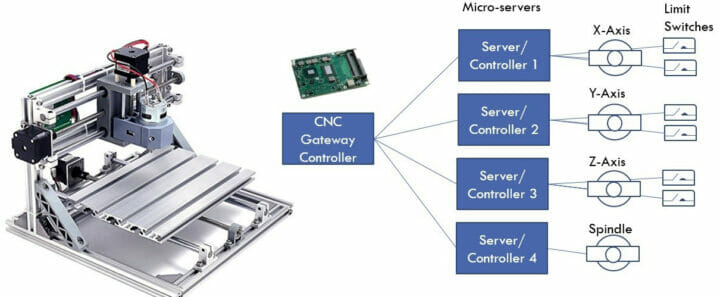The PICMG consortium is better known for COM Express and COM HPC standards for x86 industrial computers-on-module, but last year they started catering to the IIoT sector with the introduction of the microSAM System-on-Module (micro Sensor Adapter Modules) standard for microcontrollers and IIoT sensors.
The consortium has now ratified the IoT.1 firmware specification defining a communication standard between sensors/effecters and local IoT controllers such as microSAM specified by PICMGs IoT.0 specification.
 The PICMG IoT.1 standard, developed in collaboration with the Distributed Management Task Force (DMTF), defines a vendor-agnostic firmware interface and low-level data model that builds upon the Platform Level Data Model (PLDM) low-level messaging system, and adds features specific to industrial automation and control use cases.
The PICMG IoT.1 standard, developed in collaboration with the Distributed Management Task Force (DMTF), defines a vendor-agnostic firmware interface and low-level data model that builds upon the Platform Level Data Model (PLDM) low-level messaging system, and adds features specific to industrial automation and control use cases.
If like me, you’ve never heard about PLDM, PICMG explains:
The PLDM is a low-level messaging system that supports topologies, eventing and discovery and runs over a variety of system level buses such as I2C/SMBus and PCIe VDM (Vendor-Defined Message) over MCTP (Management Component Transport Protocol) as well as RBT (RMII-Based Transport (RMII = Reduced Media Independent Interface)) over NC-SI (Network Controller Sideband Interface).
That’s still very abstract to me, but let’s continue with the four main benefits list for the IoT.1 specification:
- Enable sensor vendors to create smart sensors without having to manufacture the control circuitry and/or software by purchasing these components from PICMG-compliant suppliers
- Enable controller suppliers who wish to create smart sensors or smart-sensor components to do so in a way that is interoperable with other suppliers
- Enable sensor/effecter integrators to integrate sensors/effecters from multiple vendors with controllers from multiple vendors
- Accelerate the uptake of smart-sensor technology through open-specifications and interoperability
So the main goal here, like with most standards, is to improve interoperability, so manufacturers can rely on compliant PICMG IoT.1 modules, firmware, and sensors/effecters/actuators controllers from any vendors, and everything should work out of the box including network integration with plug-and-play interoperability.
Companies involved in the development of the IoT.1 standard include Arroyo Technology, nVent, Triple Ring Technologies, and Sandy Systems, so we should shortly expect compliant products from those companies. The specification is said to be open but costs $750 to download (The IoT.2 references on that page must be a mistake). The PICMG also provides a more detailed explanation of their goal with IIoT standards, notably highlighting RedFish RESTful interface for the remote management of a platform.


Jean-Luc started CNX Software in 2010 as a part-time endeavor, before quitting his job as a software engineering manager, and starting to write daily news, and reviews full time later in 2011.
Support CNX Software! Donate via cryptocurrencies, become a Patron on Patreon, or purchase goods on Amazon or Aliexpress





Open and paywall protected are contradictory. This looks like one to ignore.